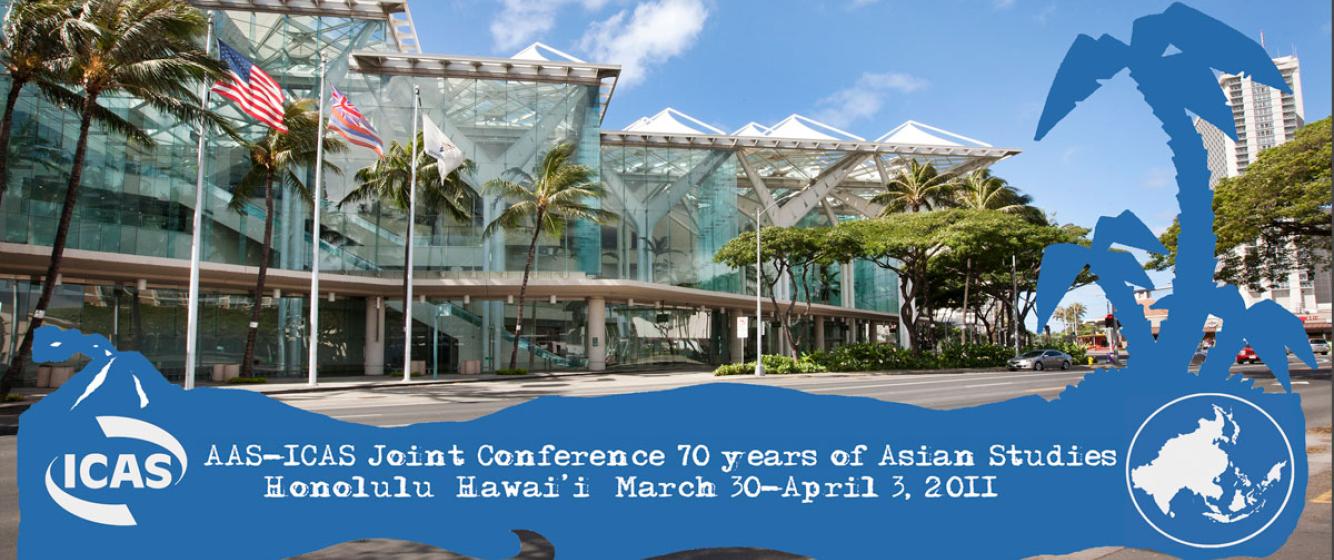
ICAS 7 - Honolulu
ICAS 7, Honolulu
31 March–3 April 2011
During ICAS 4 (Shanghai, 2005) a delegation of AAS board members and the ICAS Secretariat had suggested the idea to organise a joint AAS-ICAS ‘meet’. It took a while before we agreed on a location, yet eventually Honolulu rose on the horizon as the obvious choice. After intensive negotiations an agreement was signed in Philadelphia in 2010. Since it was the 70th birthday of AAS the theme was ‘Celebrating 70 Years of Asian Studies’. Both the AAS and the ICAS Secretariats had to work full speed to deal with the unprecedented number of submissions. AAS took care of all panel submissions, and ICAS put together no less than 350 panels based on an inflow of 2500 individual abstracts, mostly from Asia.
An impressive 5,000 participants gathered in the Honolulu Convention Center from 31 March to 3 April 2011 making it the biggest meet in the field of Asian studies so far. The reception was sponsored by the University of Hawai’i at Mānao, the East-West Center and the Confucius Institute. It was a memorable meeting, which kicked off with the welcome reception on the Great Lawn at the Hilton Hawaiian Village and Beach Resort & Spa overlooking the Pacific. The Kenny Endo Taiko Ensemble on Japanese drums entertained the participants while a fireworks display further added lustre to the gathering. The gaiety of the reception was understandably tempered by the 11 March Tōhoku earthquake and subsequent tsunami on the east coast of Japan. A Japanese princess was present at the official opening of the joint meeting and thanked the inhabitants of Hawai'i and those present on behalf of the Japanese people for their support.
Nearly 800 panels were included in a programme book as thick as the phone book. It was more than triple the size of our regular conferences and a large number of them were in the category ‘Border Crossing and Inter-area’. A bewildering variety of topics were discussed ranging from ‘Literary Monsters and Demons’ to ‘Global Representation of China’ and ‘Women in Asia’ to ‘Media and the Message’. In the main lobby of the Convention Center there were continuous musical performances, and for the first time a professional photographer was engaged who made a colourful impression of this memorable meeting, sending out a clear signal to the outside world that Asian studies is a thriving and vibrant community.
While the structure, activities, and culture of each organization (AAS and ICAS) vary somewhat, they share the common goals of promoting the study of Asian and transcending boundaries between disciplines, nations, and geographic origins of scholars of Asia – K. (Shivi) Sivaramakrishnan, AAS President
Our joint gathering was from the outset both a risk and a challenge but it paid off in many respects, foremost in terms of attendance. More than 2,000 scholars hailing from Asia set in motion further internationalisation of Asian studies and triggered the annual AAS-in-Asia meetings, which started in 2015. The ICAS Book Prize received a massive 200 submissions, prompting the reading committee to put in place Accolades, so as to recognise a larger subset of titles, including ‘Publishers Accolade for Outstanding Production Value’, the ‘Edited Volume Accolade’ and ‘Teaching Tool Accolade’.